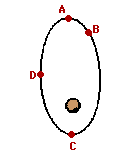PHYSICS CHAPTER 25 NOTE PACKET CHAPTER 25 ROCKETS AND
PHYSICS DEPARTMENT PROFORMA RESEARCH PROPOSAL CONFIRMATION FOR DIRECT1 PHYSICS OF BIOLOGICAL SYSTEMS CONRAD ESCHER HANSWERNER
10282004 PHYSICS 556714 NUCLEI AND ELEMENTARY PARTICLES PHY 556714
112 SPRINGS CALCULATION SHEET AQA PHYSICS QUESTIONS 1 WHEN
196 ANALYSING STARLIGHT FOLLOWUP SHEET OCR PHYSICS A WAVELENGTH
2 FOUNDATIONS OF PHYSICS CALCULATION SHEET OCR PHYSICS A
VOLCANOES AND PLATE TECTONICS
PHYSICS: CHAPTER 2.5 NOTE PACKET
Chapter 2.5: Rockets and Satellites
Vocabulary: Define the following terms from Chapter 2.4.
Satellite-any object that orbits another object in space.
Centripetal Force-Any force that causes an object to move in a circular path.
Chapter 2.5: Rockets and Satellites
Notes:
Rockets and Satellites
HOW DO ROCKETS LIFT OFF?
Newton’s THIRD LAW(ACTION / REACTION)
Rocket pushes hot gases DOWN
Hot gases push rocket UP
UNBALANCED forces accelerate the rocket upward
Net Force = THRUST
“A ROCKET CAN RISE INTO THE AIR BECAUSE THE GASES IT EXPELS WITHA DOWNWARD ACTION FORCE EXERT AN EQUAL BUT OPPOSITE REACTION FORCE ON THE ROCKET.”
What is a Satellite?
ANY OBJECT THAT ORBITS ANOTHER OBJECT IN SPACE.
Natural: MOONS AND ASTEROIDS
Artificial: MAN-MADE OBJECTS
Circular Motion
Satellites follow an almost perfectly circular path around the Earth.
The FORCE that keeps an object in a circular path is called a CENTRIPETAL FORCE:
GRAVITY is the centripetal force holding satellites in orbit around the Earth.
TENSION is the centripetal force of a string holding a ball moving in a circle.
FRICTION is the centripetal force of the road and the tires of a car moving around a curve.
QUESTION: WHAT TYPE OF FORCE CAUSES AN OBJECT TO MOVE IN A CIRCULAR PATH? ________________________________________________
SATELLITE MOTION
SATELLITES IN ORBIT AROUND EARTH CONTINUOUSLY FALL TOWARD EARTH, but because Earth is CURVED they travel around it.
Fig. 21, page 66.
SATELLITE LOCATION
Low Orbit
400 km: SPACE SHUTTLE
1000 km: RESEARCH SATELLITES
High Orbit
36,000 km: Communication satellites
GEOSYNCHRONOUS ORBIT
Orbiting Earth, but STAYING ABOVE THE SAME LOCATION.
Chapter 2.5: Rockets and Satellites
Assessment Questions
Which of Newton’s three laws of motion explains how a rocket lifts off?
Newton’s third law of motion
How do action-reaction pairs explain how a rocket lifts off?
A rocket can rise into the air because the gases it expels with a downward action force exert an equal but opposite reaction force on the rocket.
As a rocket travels upward from Earth, air resistance decreases along with the force of gravity. The rocket’s mass also decreases as its fuel is used up. If thrust remains the same, how do these factors affect the rocket’s acceleration?
Newton's All three factors increase the rockets acceleration. Decreased air resistance and force of gravity allow the rocket to accelerate faster because both result in less force opposing the rocket’s acceleration. Decreased rocket mass increases acceleration because the same force is acting on a smaller mass.
What is a satellite?
A satellite is an object that orbits another object in space.
What causes satellites to stay in orbit rather than falling toward Earth?
Satellites stay in orbit because earth’s surface curves away as Earth’s gravity causes them to fall toward earth.
A projectile is thrown with enough velocity to orbit Earth. What would happen if the projectile were thrown with a greater velocity?
If the projectile were thrown with a greater velocity, it would escape earth’s gravity and move off into space.
Draw a diagram showing the motion of a satellite around Earth. Label the forces acting on the satellite. Is the satellite accelerating? Explain.
 A
satellite is accelerating towards the Earth due to the force of
gravity.
A
satellite is accelerating towards the Earth due to the force of
gravity.
A satellite does fall towards the Earth; only it never falls into the Earth because Earth is curved.
2 SOLID STATE PHYSICS (INDIA) 45 (2002) XXXXXY PROCEEDINGS
20TH GAMOW INTERNATIONAL ASTRONOMICAL CONFERENCESCHOOL ASTRONOMY AND BEYOND ASTROPHYSICS
295407-electricity-sensing-waves-and-quantum-physics-mcq-topic-quiz-lesson-element
Tags: chapter 2.5, location. chapter, chapter, packet, physics, rockets
- PROVIDER NEUTRAL RECORD GUIDELINES FOR ONLINE SERIALS (EXCERPT FROM
- PENNSYLVANIA STATE FFA SAFE TRACTOR DRIVING CDE ENTRY FORM
- W EST CUMBRIA BRANCH THE WEST CUMBRIA BRANCH OF
- PROCEDIMIENTO PRODUCTO NO CONFORME CÓDIGO SC02P03 REVISIÓN VERSIÓN INICIAL
- MUĞLA İÇİN SENİN DE SÖZÜN OLSUN SLOGAN YARIŞMASI TÜRKIYE’NIN
- LETTURE PATRISTICHE1 «DEL BATTESIMO DEL SIGNORE» I PER L’ANNO
- 09CNWSebel_CitigateBookingForm_01mr
- THE THESIS STATEMENT AND TOPIC SENTENCES (45) THE THESIS
- M ATEMATICA – PRIMERO DE PRIMARIA ESCRIBIMOS LITERALMENTE NÚMEROS
- NÁVOD NA POUŽITÍ SPORT TESTER BION A300 PŘED POUŽITÍM
- ÁREA DE FOMENTO Y EMPLEO DEL 16 DE SEPTIEMBRE
- PÉNZÜGYMINISZTÉRIUM ÚTMUTATÓ 61 344 03 OKLEVELES ADÓSZAKÉRTŐ SZAKKÉPESÍTÉS 61
- NAME DUTCHTOWN HIGH SCHOOL SENIOR RESEARCH PAPER RUBRIC CONTENT
- COURT COPY MAGISTRATES COURT OF WESTERN AUSTRALIA APPLICATION
- LA CLÁUSULA DE ACELERACIÓN DESDE FINES DE LA DÉCADA
- MÉTODOS PARA IDENTIFICACIÓN DE FIBRAS VEGETALES DE TEXTIL PREHISPÁNICO
- F ORMULARZ REKRUTACYJNY NA STUDIA PIERWSZEGO STOPNIA PROSZĘ O
- 0 EVROPSKI EKONOMSKOSOCIALNI ODBOR SOC373 ZAKONITO PRISELJEVANJE
- TÜRK VE YABANCI SIVIL HAVA ARAÇLARI MALI MESULIYET SIGORTASI
- JEDNOLITE MAGISTERSKIE STACJONARNE STUDIA PRAWA III ROK ĆWICZENIA Z
- RELACIÓN DE SOLICITUDES APROBADAS EN LA LV COMISION MIXTA
- CHARAKTERYSTYKA PRODUKTU LECZNICZEGO 1 NAZWA PRODUKTU LECZNICZEGO OCULOTECT FLUID
- U NIVERSIDAD NACIONAL DE RÍO CUARTO FACULTAD DE CIENCIAS
- ROMÂNIA MINISTERUL EDUCAŢIEI SI CERCETARII LICEUL CU PROGRAM SPORTIV
- INTRAEU IMMIGRATION POLISH PLUMBER PROBLEM OR POSITIVE ECONOMIC INGREDIENT?
- DEAR SIRMADAM SUBJECT REQUEST FOR PROPOSALS FOR CONSULTING SERVICES
- POLIZA DE RESPONSABILIDAD CIVIL POSESIÓN Y USO DE ARMAS
- P G R PROCURADURIA GENERAL DE LA REPUBLICA INRH01
- STORY UN PEDAL PARA APARCAR LA INNOVACIÓN HA FORMADO
- THE REVIEW PROCESS WHAT HAPPENS TO YOUR APPLICATION I
XXII ENCONTRO GALEGOPORTUGUÉS DE EDUCADORASES POLA PAZ VIGO 18
 PRIPRAVE NA VZGOJNOIZOBRAŽEVALNO DELO IN UČNA GRADIVA MEDPREDMETNO SODELOVANJE
PRIPRAVE NA VZGOJNOIZOBRAŽEVALNO DELO IN UČNA GRADIVA MEDPREDMETNO SODELOVANJE OFENSIVA DE PRODUCTO LOS TRES SUV DE SEAT RUEDAN
OFENSIVA DE PRODUCTO LOS TRES SUV DE SEAT RUEDAN ANALISIS FINANCIERO OBJETIVO DOTAR A LOS PARTICIPANTES DE UN
ANALISIS FINANCIERO OBJETIVO DOTAR A LOS PARTICIPANTES DE UN CLABDSIDJAN11ITEM04 PAGE 3 OF 3 CALIFORNIA DEPARTMENT OF EDUCATION
CLABDSIDJAN11ITEM04 PAGE 3 OF 3 CALIFORNIA DEPARTMENT OF EDUCATIONCRIME STATISTICS CRIME STATISTICS AND FIGURES CANNOT BE
 Planiranje Projektapisanje Prijedloga Projekta Ovaj Materijal Izradili su
Planiranje Projektapisanje Prijedloga Projekta Ovaj Materijal Izradili su REPUBLIC OF LATVIA CABINET REGULATION NO 201 ADOPTED 22
REPUBLIC OF LATVIA CABINET REGULATION NO 201 ADOPTED 22 CHAPTER III – REVIEWS RELATING TO STATUTORY CORPORATIONS HIGHLIGHTS
CHAPTER III – REVIEWS RELATING TO STATUTORY CORPORATIONS HIGHLIGHTSZAŁĄCZNIK NR 6 DO UCHWAŁY NR XXX1542018 RADY GMINY
BALLOT TAX (FORM CH62) 1 BRACKEN 2
DISEÑO DE LA ACTIVIDAD PARA EDUCACIÓN PRIMARIA AUTOR RAIMUNDO
 PHOTOSYNTHESIS WITH ALGAL BALLS STUDENT SHEET SAFETY NOTES THERE
PHOTOSYNTHESIS WITH ALGAL BALLS STUDENT SHEET SAFETY NOTES THEREEL TEATRO EUROPEO MODERNO SHAKESPEARE Y MOLIÈRE 1 EL
 WATERMARK EĞİTİM DAİRESİ BAŞKANLIĞI TSE DIŞINDAN GÖREVLENDİRİLECEK SINAV GÖREVLİSİ
WATERMARK EĞİTİM DAİRESİ BAŞKANLIĞI TSE DIŞINDAN GÖREVLENDİRİLECEK SINAV GÖREVLİSİ318 PILLANATKÉP A PSZICHOLINGVISZTIKÁRÓL PILLANATKÉP A PSZICHOLINGVISZTIKÁRÓL FOGÓDZÓK ÉS
 EXPERT SYSTEM ARCHITECTURE FIGURE SHOWS THE MOST IMPORTANT
EXPERT SYSTEM ARCHITECTURE FIGURE SHOWS THE MOST IMPORTANT DUBLIN REPUBLICAN CLUB MEMBERSHIP APPLICATION FORM WWWDUBLINGOPORG INFODUBLINGOPORG
DUBLIN REPUBLICAN CLUB MEMBERSHIP APPLICATION FORM WWWDUBLINGOPORG INFODUBLINGOPORG JU MJEŠOVITA SREDNJA HEMIJSKA ŠKOLA TUZLA GRAFIČKA TEHNOLOGIJA I
JU MJEŠOVITA SREDNJA HEMIJSKA ŠKOLA TUZLA GRAFIČKA TEHNOLOGIJA ICONQUEST COPYRIGHT NOTICE CONQUEST IS COPYRIGHT © 1990